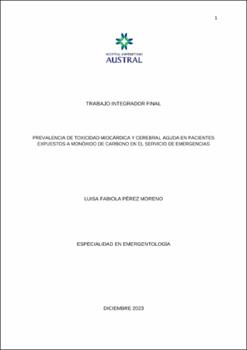| dc.contributor.author | Pérez, Luisa. | |
| dc.contributor.author | Zúñiga, Carolina. | |
| dc.contributor.author | Lisperguer, Shirley. | |
| dc.contributor.author | Et al. | |
| dc.date.accessioned | 2024-03-08T14:45:54Z | |
| dc.date.available | 2024-03-08T14:45:54Z | |
| dc.date.issued | 2023-12 | |
| dc.identifier.citation | Pérez, Luisa. Prevalencia de toxicidad miocárdiaca y cerebral aguda en pacientes expuestos a monóxido de carbono en el servicio de emergencias. Trabajo integrador final. Especialidad en Emergentología. Buenos Aires, Hospital Universitario Austral; 2023 | es |
| dc.identifier.uri | https://riu.austral.edu.ar/handle/123456789/3072 | |
| dc.description.abstract | Abstract
Introduction: Due to its severe toxicity, carbon monoxide poisoning is an emergency
that leads to cardiac and brain involvement, and emergency physicians should aim to
master this diagnosis. This study is intended to describe the expected prevalence of
these severe toxicities in the emergency department.
Materials and Methods: A retrospective cohort of consecutive patients over 16 years
of age presenting with carbon monoxide poisoning to the emergency department of
the Hospital Universitario Austral, Argentina, during the period from January 2018 to
June 2022. The prevalence of myocardial and brain toxicity was assessed regarding
percentage, continuous variables with mean and standard deviation, categorical
variables with percentage and absolute frequency. Positive findings of acute
neurological toxicity included seizures, syncope and coma, while cardiovascular
toxicity encompassed acute myocardial infarction (MI) diagnosed by
electrocardiogram or elevated troponin levels, arrhythmias, and the development of
pulmonary edema/ congestive heart failure (CHF) confirmed by chest X-ray with
suggestive signs or clinically compatible symptoms. Patients were followed-up for 90
days to estimate hospitalization and mortality.
Results: A total of 67 patients were evaluated; 44.77% of them were males with a
mean age of 38.5 ± 14.97 years. The prevalence of acute myocardial toxicity was
7.46% (n: 5). Among these patients, 3 had overweight as a risk factor, and 3 showed
ECG abnormalities with negative T-waves. The prevalence of acute brain toxicity was
8.9% (n: 6). In total, 37% (n: 25) of patients met the criteria for hyperbaric oxygen
therapy, of which 32% (n: 8) underwent more than one session. A total of 7.46% of
patients (n: 5) required hospitalization. Mortality at 90 days was 0%.
Conclusion: Among the patients who presented to the emergency department, the
prevalence of acute myocardial toxicity was 7.46% (n: 5), which is lower than the
prevalence reported in other studies to date. The prevalence of acute brain toxicity
was 8.9% (n: 6), and there are no studies describing the prevalence of acute brain
toxicity in the emergency department to date. There were no fatalities in our series. | es |
| dc.language.iso | es | es |
| dc.publisher | Hospital Universitario Austral | es |
| dc.rights | Attribution-NonCommercial-NoDerivatives 4.0 Internacional | * |
| dc.rights.uri | http://creativecommons.org/licenses/by-nc-nd/4.0/ | * |
| dc.subject | Envenenamiento por monóxido de carbono | es |
| dc.subject | Toxicidad miocárdica | es |
| dc.subject | Hospital Universitario Austral | es |
| dc.title | Prevalencia de toxicidad miocárdiaca y cerebral aguda en pacientes expuestos a monóxido de carbono en el servicio de emergencias | es |
| dc.type | masterThesis | es |


